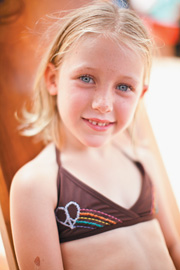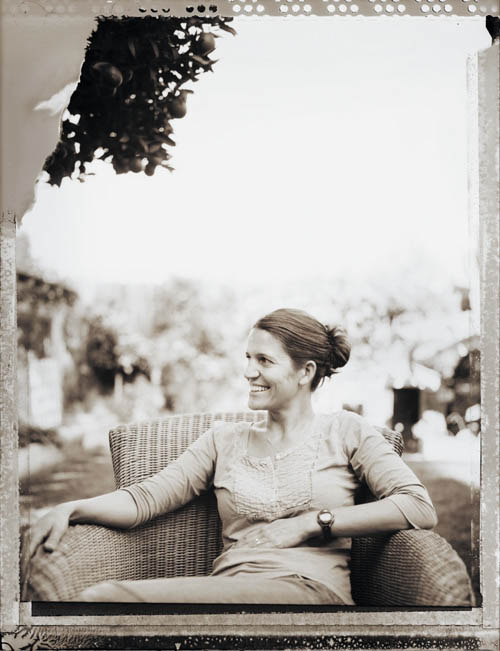3. Style and Substance

Jack Johnson is often described by what he does: musician, surfer, filmmaker, artist, and environmentalist. The way he lives his life and approaches his craft goes far beyond such ordinary terms. It’s not what he does but how he does it. Jack has a style that is distinct and completely his own. Here he is pictured just steps from the beach near his home.
Canon 5DMii, 50mm lens, f/2.5
STYLE IS LIKE the inaudible hush you experience when everything seems right. Like when you walk into someone’s well-designed home. At least that’s what I felt when I crossed the threshold of a musician’s beach bungalow for a photo shoot. It was impossible to say what stood out the most, because nothing stood out at all—everything fit together and belonged. The warm welcome, humble furnishings, stack of colorful surfboards, barefoot kids running on the bamboo floors, the living room full of vintage instruments, and the eclectic art. Everything came together in such a California beach-cool and natural way.
Style is something that is difficult to pin down, yet seeing is often how we notice it first. That’s why it’s easy to misinterpret style as surface, but that just isn’t quite right. Style is something more permanent and profound. I prefer to think of style as an inner core. In photography, strong style is the substance that immediately defines and unifies one person’s work. The best style is something that is distinct and sets us apart.
Stitching and Thread
My photography students constantly wrestle with how to develop a visual voice or style of their own. In an effort to help, I once asked a classroom full of students if they were ready to begin creating a cohesive visual direction for their work. Without hesitation, they all replied, “Yes.” I replied, “OK, here’s the first step: Describe your photographic style.” This was a setup, because I knew they wouldn’t come up with much. For beginning students, style is too elusive and difficult to verbally describe. As predicted, no one knew what to say; it was too nebulous of a task. Everyone slunk down in his or her chair.

My daughter Annika sitting on a Costa Rican beach. This picture contains a few elements of style that I value most: authentic, natural, warm, hopeful, beautiful, beach, travel, and love.
Canon 5DMii, 50mm lens, f/2
Next I said, “OK, that didn’t work, let’s try something else. This time describe the type of photographic style you aspire to by comparing it to food.” Their answers came quickly and they were colorful and true. Let me share a few that stood out. Dawn, a student from Texas, enthusiastically explained, “I want my photographic style to be like a soufflé. At a distance it seems simple but really it’s layered and complex...and it’s filled with a surprise!” Oddur, a student from Iceland, replied, “Every New Year’s Day my extended family would gather and we would eat one special spoonful of caviar. I want my photographic style to be like caviar—it’s not something everyone likes, but those who like it are committed beyond means.”
What wonderful and poignant descriptions about photographic style! As we went around the classroom and each student shared, we were all on the edge of our seats. Suddenly, we were given a clue about the personal thread that held together each student’s work, like the stitching that held together the folded sails of their ship. When they lifted the sails up, we could see the threads that had always been there. By raising the sails, it enabled them to be filled with a fresh breeze.
Exercise: Defining Your Style
Style is something that doesn’t happen all at once but one picture at a time. Trying to make style happen quickly is contrary to its path. After years of shooting we can look back and of course it all makes sense. Looking forward seems like an impossible task. In order to create powerful people pictures, you need to articulate the inner core or substance of the photographs that you want to make. That way, regardless of the subject, your work can have a cohesive thread.
Here are a few steps to help you make this process more concrete by developing comparative terms. For most of us, our style isn’t exactly where we’d like it to be. Therefore, approach this exercise by describing the style you would like to have.
Step 1 25 Objects
Take 15 minutes to brainstorm about physical objects—write without restraint the things you like most. Here are a few ideas to help you start: flip-flops, mountain bike, cooking knife, hand-knitted blanket, driftwood, bright yellow tent. After you have compiled a list of 25 items or more, circle the top five.
Tips
Using comparative terms to describe your style may feel silly or trite. Yet don’t pass on this exercise until you have given it a try. Using comparative language can be a powerful method for unlocking ideas that you carry inside.
When describing your photographic style by comparing it to something else, it might seem obvious at first. So try comparing notes with a friend who takes photos. By doing this you’ll discover just how distinct all of your answers actually are.
Next write down the top five on a separate sheet of paper and add descriptions of why you like each item. Write the descriptions in a way that helps you uncover your own photographic sensibility. For example, I like driftwood because it has traveled a long way through rivers and oceans, and it has been softened and has settled on the shore. I like that it is natural, imperfect, and unique.
Step 2 Seasonal Colors
Color has the power to evoke feeling and mood. Artists pay attention to color and use it to convey ideas. My mom is an artist and has a set of favorite colors for each time of the year. Following her footsteps, take 15 minutes to write down the colors you associate with the four seasons—winter, spring, summer, and fall.
Next find some colored pens or an old box of crayons. Create small color palettes for each season and write about the moods that each season evokes in you. Don’t worry about being critical; just write what you feel. For example, spring is green, bright, and healthy. Alive and verdant—spring is yellow, fuzzy duckling yellow. Soft, full of hope, and sincere. After writing about all four seasons, choose the color palette and mood that best describe the style of pictures you would like to make.
Exercise Details
Goal: Clarify your vision, voice, and style. Tools: Notebook or journal. Theme: Style. Duration: 1 hour.
Step 3 Weather
Weather creates atmosphere, emotions, and depth. Who we are and the photographs we make are directly and indirectly affected by the weather where we live. Take 15 minutes and write down the weather details for your ideal photo shoot. If you had your way, what type of weather would you request: the subdued quiet that comes from a thick and muted fog, the drama and excitement from a passing storm, or the optimism of the bright morning sun? Describe the weather that matches the photographs that you want to make.
Step 4 Music
I once asked photographer Rodney Smith what music he would choose to be a sound track to his life’s work. Without a pause he responded, “Aaron Copland!” and then he continued in a more quiet tone, “if ever I could create a photograph with the same intensity of his songs.”
How about your own photographic work; what music would you choose to accompany your pictures and why? If there isn’t a particular musician or composer that you like, try choosing an instrument or more generalized style of music. Take 15 minutes and listen to your favorite type of music, then pick the option that fits best.
Step 5 Food
Now it’s your chance to answer the question that I asked my students. Take 15 minutes to describe the photographic style you would like to acquire. Make a comparison to food and provide a reason why. After you have answered this yourself, ask a few colleagues for their own response and compare notes.
OPPOSITE This photograph of my wife, Kelly, was a collaboration between me and my three-and-a-half-year-old daughter Sophia. I took the first picture, which didn’t turn out very well. Sophia asked if she could try. I loaded the film, passed off the shutter release, and walked away. She directed Kelly to look to the side and created this beautiful frame. This picture captures an important aspect of my style aspirations; that photography is something that isn’t just for me but for everyone involved.
Wood large format 4 × 5, 90mm lens, f/5.6, Polaroid Type 55 Film
“Style has no formula, but it has a secret key. It is the extension of your personality.”
—Ernst Haas

